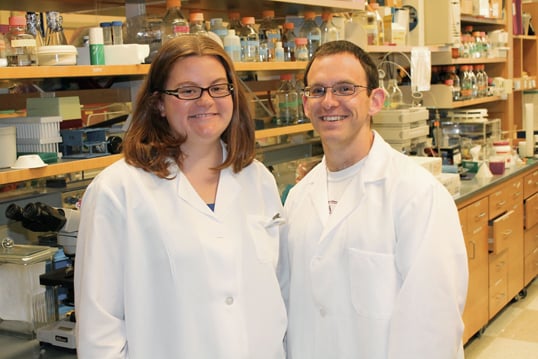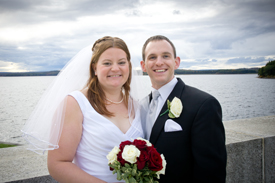
Heidi and Andrew Malaby, who met as GSBS students and later married, are pursuing postdoctoral fellowships that will build on their GSBS training.
When Heidi Hafemann and Andrew Malaby met in 2007 as first-year students at the Graduate School of Biomedical Sciences, they both shared a passion for scientific research. By the end of second year, they had discovered other mutual interests: reading, hiking and each other.
Married in 2011 and about to be hooded as Doctors of Philosophy in the Program in Biochemistry & Molecular Pharmacology at Commencement 2014, the Malabys are pursuing postdoctoral fellowships that will build on their GSBS training, help prepare them for their next career moves—and share neighboring zip codes as they begin a new chapter in their life together.
“Having someone who understands when you work late to finish an experiment, or get up early to begin one, is incredibly important to me,” said Andrew Malaby, who works in the lab of David Lambright, PhD. Heidi Malaby works in the lab of William Kobertz, PhD.
Both Malabys are seeking traditional postdoctoral fellowships, with their goal to eventually land traditional academic appointments running their own research labs. They are looking for the best scientific opportunities in the places where they would most like to live, but if those criteria don’t align, they anticipate that the science will prevail. They are also interested in the opportunities that postdoctoral fellowships offer to sharpen teaching and research skills.
“We both really like teaching, and what we’re learning in our interviews is that there is a spectrum of emphasis on research versus teaching in academic careers,” said Heidi Malaby. “I don’t know where on that spectrum I’m going to fall yet.”
“Your postdoctoral training is where you’ll get really specific experience for what you’ll be doing, in terms of teaching experience as well as scientific focus,” Andrew Malaby concurred. “We’re considering that as we interview and are hoping for multiple offers from which to choose.”

Heidi and Andrew Malaby were married in 2011, four years after meeting as first-year students at the Graduate School of Biomedical Sciences. PHOTO COURTESY OF TINA BLUMER PHOTOGRAPHY
Working at a local biotechnology firm for a year after graduating from Springfield College with a degree in sports biology (he was a varsity gymnast) cemented Andrew Malaby’s decision to pursue a PhD in biomedical sciences; as his blog handle says, he has been ‘discovering the secrets of cellular traffic one molecule at a time,’ as a student of structural biology in the laboratory of Dr. Lambright, professor of molecular medicine and biochemistry & molecular pharmacology. Andrew Malaby’s thesis research into how guanine nucleotide exchange factors are regulated by their substrates, Arf GTPases, has implications for understanding how many infectious diseases ‘take over’ a cell. “I've looked at the atomic details underlying a feedback loop where the Arf GTPase acts to stimulate its own exchange factor and recruit it to the cell surface," he noted. “Bugs like certain bacteria can insert their own proteins into the host pathways such as this one.”
Heidi came to the GSBS from Bowling Green State University, where she majored in biology. Under the mentorship of Dr. Kobertz, associate professor of biochemistry & molecular pharmacology, Heidi’s thesis research focused on sugars which act as ‘postage stamps’ in the N-glycosylation of proteins. “N-glycosylation is a process that happens in every cell in your body that helps deliver proteins from where they’re made to where they do their job,” she said. “A little group of sugars is attached to proteins after they’re made and act as a ‘postage stamp;’ if cells don’t have the sugar group attached in a timely manner they don’t get where they need to go. We’ve found that there are very small differences in the proteins, really just a few atoms, that dictate when the sugars are attached.” Abnormal N-glycosylation has been associated with the cardiac condition Long-QT Syndrome as well as a spectrum of neurological disorders.
While facing the future with a mixture of anxiety and anticipation, the Malabys are already looking back fondly and gratefully on their years at the GSBS.
“I’ve grown incredibly, both scientifically and professionally, while I’ve been here,” said Heidi Malaby. “Part of why I want a postdoc is that I want a crack at another project where I can start at my current skill level. I want to see what I can accomplish.”
Andrew Malaby agrees with his wife. “I feel prepared to take on new challenges and new topics. Both of us are looking at changing research topics and techniques,” he said. “We are ready to do take on huge changes and new learning experiences.”
Is there a doctor in the house?
By Heidi Malaby
Last month was my defense and . . . I passed! It doesn’t seem like I’ve been in graduate school for seven years. That’s the funny thing about science research: time flies by at an exorbitant rate.
Working with Bill Kobertz, PhD, I was able to figure out some pretty wild things about the process of N-glycosylation. This is a routine activity that happens in all cells in which a sugar group is attached to new proteins and acts like a postage stamp. These sugars allow the proteins to clear different check points in the cell so they can move around to different compartments and eventually get to where they need to be. While studying how this sugar group is attached, we found several features in the protein’s make up (i.e., the order and type of amino acids) that determine when and how well this sugar group is attached. Our lab also discovered that a cardiac arrhythmogenic disease called Long QT Syndrome can be caused by a particular protein not getting this sugar group attached at the right time. With my findings, we’re one step closer to helping improve the sugar group attachment for proteins with mutations that wouldn’t otherwise get that all important postage stamp.
These findings have allowed me to first author two manuscripts (one is published, the other is in the review process), and a nice, long thesis that my defense committee got the pleasure of reading. My defense was a great experience, and I really appreciated so many colleagues, friends and family coming out to be part of the day with me. It’s a fantastic reminder that, even though you sometimes feel isolated working at the bench by yourself, there really are so many people out there rooting for you to succeed.
As my days at UMass Medical School are dwindling down, I can look back at my personal journey over the last seven years and see how much I’ve grown. I had a little lab experience before starting the graduate school program here, but I was nowhere near the level of designing my own experiments, let alone asking my own questions. There was just so much I didn’t know.
It took awhile, maybe a solid three years of tinkering around the lab before it all started to click for me: learning how to design solid experiments and implement them in a way that gives you conclusive results every time; figuring out what you can learn from every experiment you do (because there’s always something); formulating theories consistent with your results, and designing new experiments to test those theories; learning how to write for the scientific community, and how to replace the jargon to communicate my research with my local community as well.
After finishing up a few last things in the lab, I’ll be moving on to a post-doctoral position. I’m still looking, but I love the cell biology/biochemistry combo I’ve landed in and there are a lot of great opportunities out there. Wherever I end up, I know that I have the ability to succeed in whatever I do, thanks in large part to the transferable critical thinking skills developed at UMass Medical School.
Heidi Malaby was a regular blogger for the Hudson Hoagland Society, a non-profit organization that provides critical resources for scientists to pursue new lines of investigations and discovery. She adapted one of her posts for this essay.
Related link on UMassMedNow:
Biomedical graduate students take science on the road